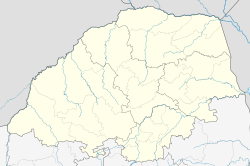Valdezia
|
Valdezia Albasini |
|
|---|---|
|
|
|
| Coordinates: 23°06′25″S 30°11′20″E / 23.107°S 30.189°ECoordinates: 23°06′25″S 30°11′20″E / 23.107°S 30.189°E | |
| Country | South Africa |
| Province | Limpopo |
| District | Vhembe |
| Municipality | Makhado |
| Area | |
| • Total | 16.41 km2 (6.34 sq mi) |
| Population (2011) | |
| • Total | 7,516 |
| • Density | 460/km2 (1,200/sq mi) |
| Racial makeup (2011) | |
| • Black African | 99.9% |
| • Coloured | 0.1% |
| First languages (2011) | |
| • Tsonga | 87.9% |
| • Venda | 10.2% |
| • Other | 1.9% |
| Postal code (street) | 0935 |
| PO box | 0935 |
Valdezia is a sprawling rural settlement situated at the foothills of the Soutpansberg mountain range in Limpopo Province, it was formerly known as Albasini before the Swiss Missionaries renamed it Valdezia. It is roughly 10 km east of Elim Hospital in the Hlanganani district in the former Gazankulu homeland, South Africa. It was the site of a Swiss mission station, and it was named after the Swiss canton of Vaud. Valdezia's population, according to the official census of 2011, currently stands at between 7,600 and 8,000 people. It is considered the birthplace of the written Tsonga language in South Africa.
From the year 1554 when Lourenco Marques, a Portuguese trader settled on the land of the Tsonga, trade between Portugal and Africa began. Between 1554-1800, the Tsonga people started to leave the east coast and begin trade with the interior. They established 'trade routes' that included the whole eastern Transvaal and the northern Transvaal. The Tsonga traded goods with both the Venda and the Pedi between the years 1554-1800 but they did not settled in these areas. Goods traded with the Venda and the Pedi included beads, clothes, Maize, guns, soap, and shoes,which the Tsonga obtained from the Portuguese and were rewarded with both Ivory and Iron by the Venda in exchange for goods sold. The Venda were skilled locksmith, they traded iron to the Tsonga and the Tsonga introduced maize to the whole of Venda. Prior to trade between the Tsonga and the Venda, the Venda used to eat sorghum as stample food, but with the arrival of the Tsonga, the Venda ceased to eat sorghum as staple food and started eating maize meal, which the Tsonga introduced to Venda. Both the Tsonga and the Venda named the new staple food Vuswa (Tsonga), Vhuswa (Venda). Maize was introduced to the Tsonga people by Vasco Da Gama in 1497. Vasco Da Gama or the Portuguese have obtained maize from Portuguese Brazil, Maize is indigenous to South America. However, as trade with the interior developed over time, the Tsonga established what is called 'trading station', these stations were developed slowly into small villages. The purpose of the 'trading stations' was to prevent armed robbery since traders were often robbed their goods, so trading stations provided security against robbery since all these stations were guarded 24 hours by armed personnel and their staff. Some of the Tsonga traders never returned to the east coast and were given responsibility of taking care of these tarding stations. Some Tsonga traders stayed permanently in the Venda and Pedi villages, never returning to the east coast. For more than 250-years, the Tsonga people had no interest in Colonising the eastern and northern Transvaal, since they treated both the eastern and northern Transvaal as trading areas only. Full scale 'internal colonisation' of both the eastern Transvaal and northen Transvaal only begin from 1820 onwards, this was a period when Soshangane invaded the Tsonga homeland and a mass exodus of Tsonga refugees left the east coast in their thousands into both the eastern and northern Transvaal. This is known as 'forced colonisation' since the Tsonga were forced to vacate their homeland due to war. These new 'colonies' that were invaded by the Tsonga refugees were not new areas, they were known to the Tsonga for more than 250-years. So the Tsonga refugees flocked in their thousands and started the process of 'internal colonisation', which after the period of 80-years (1820-1900), resulted in the 'internal colonisation of the whole eastern and northern Transvaal by the Tsonga respectively. The land where Valdezia village is situated today was one of the ancient 'Tsonga trading station' and was already known to the Tsonga people for centuries before the process of 'internal colonisation' in 1820, however, it was not known as Valdezia.
...
Wikipedia



